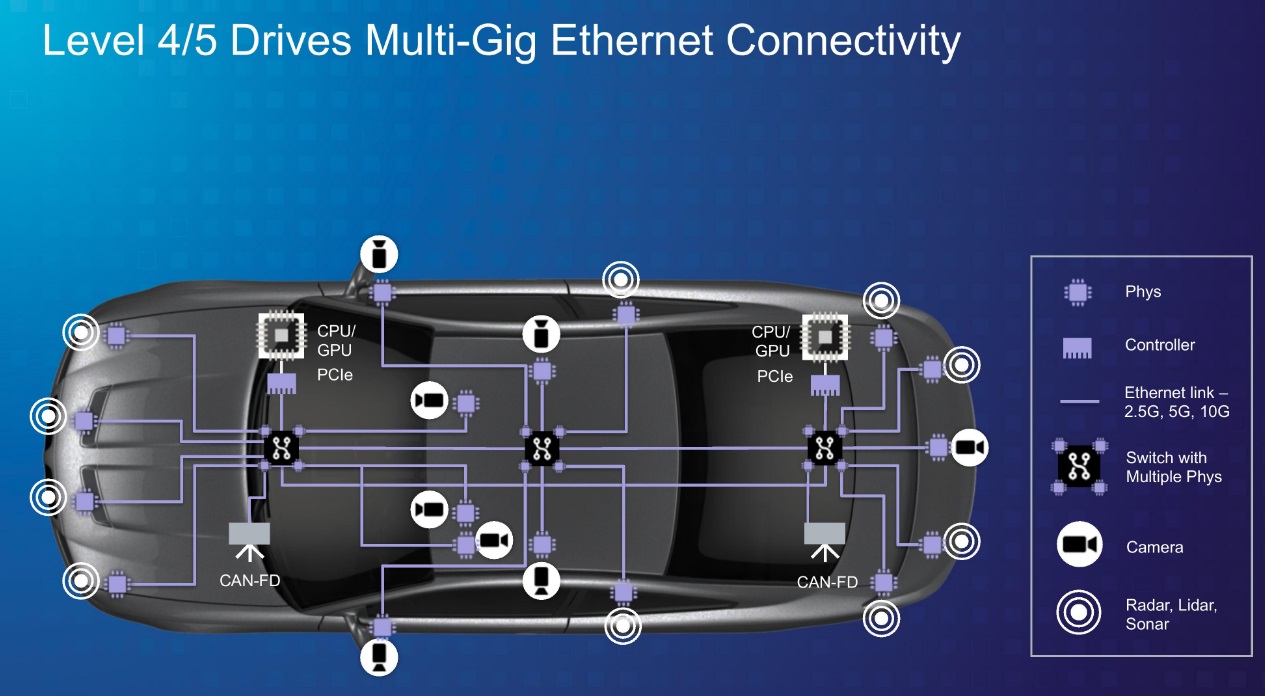
Marvell relies on Ethernet technology to create a network infrastructure platform in the emerging networked vehicle market.
This week the company announced the industry's first Gigabit Ethernet PHY. This chip also includes Media Access Control (MACsec) technology for Layer 2 security.
MACsec technology protects all stages of data transmission in automotive networks. The new PHY chip is protected against Layer 2 security threats (eavesdropping, proxy attacks, and replay attacks).
Marvell boasts a range of products that provide "the most complete data infrastructure." All products in this line are specifically designed for the data center. These products include a wide range of devices, from feed-through and carrier-based processors to PHYs and switches for network and security processors.
Will Chu, vice president and general manager of the automotive business at Marvell, told the EE Times, “We are now bringing our advanced data infrastructure expertise” to the automotive market.
Marvell is determined to take the lead in the automotive Ethernet market. The company was the first in the market to introduce 1000BASE-T1 PHY - a secure automotive switch supporting a gigabit single-pair Ethernet connection and a multi-gigabyte PHY chip. In May, Marvell also acquired Aquantia, a leader in multi-gigabit Ethernet connectivity.
Without a doubt, everyone is looking forward to the proliferation of multi-gigabit networks. In particular, such networks are needed by vehicles that have a significant need to increase network bandwidth, reduce latency and increase connection speed.
However, as Ian Richs, vice president of general automotive practice at Strategy Analytics, noted, the harsh reality is that "interfaces for working with gigabit Ethernet are not widely available today." Basically, such interfaces are built into premium or newest platforms.
Safety and energy efficiency

Marvell's new 100/1000 BASE-T1 88Q222xM PHY chip provides multi-gigabit connectivity and MACsec technology.
This chip also supports the Open Alliance TC10 standard, which describes "sleep and wake up". This technology helps to reduce the power consumption of the network modules in the vehicle. Chu argues that energy efficiency is becoming "an increasingly important automotive feature."
When asked about Marvell's new Gigabit MACsec PHY, Strategy Analytics' Richs told the EE Times: “The faster the speed, the more data. The more data, the higher the likelihood of security problems. " He also explained to us that "MACsec is a mature and reliable standard for detecting suspicious activity on Ethernet networks, thus providing protection against eavesdropping, replay attacks and middleman attacks." “Having standards-based methods like these readily available will enable OEMs to develop the end-to-end cybersecurity solutions that both the market and regulators need.”
Marvell claims the 88Q22xM is "the most energy efficient PHY with Gigabit Ethernet connectivity." This means the 88Q22xM will give OEMs the ability to design energy-efficient automotive network architectures.
Driving Factors for Adopting Gigabit Ethernet Connections in Vehicles
All things considered, will EVs be the first vehicles on the market to use Ethernet connectivity? Strategy Analytics' Rich argues that the electric vehicle market itself is not the main driver of Ethernet adoption in the automotive industry.
In turn, the list of key factors prompting OEMs to implement gigabit Ethernet networks is as follows: the creation of a centralized architecture of vehicles, domain controllers, increased network functionality of vehicles, ADAS systems and technologies for autonomous driving.
Ritchs also noted that while more and more vehicles with network functionality, ADAS systems and self-driving technologies are emerging, infrastructure developers need to be able to cope with the ever-growing traffic of automotive data. Top-of-the-line ADAS and self-driving technologies will directly affect the need for high-speed Ethernet networks.
Automotive market in a pandemic economy
Industry analysts are well aware of the impact of the Covid-19 economy on the automotive market. Egil Juliussen, author of the Egil's Eye column for the EE Times, wrote: "Car sales worldwide have plummeted and will remain below recent levels for about five years (maybe more depending on the region)."
Strategy Analytics' Richs agrees with this assessment. “The development of some new platforms will be slowed down by budget cuts and restructuring caused by the Covid-19 pandemic. We are currently making forecasts up to 2027. We continue to expect a full network architecture based on domain controllers and gigabit Ethernet connectivity to be introduced in a smaller proportion of new vehicles. ”
However, Richs added: “All this does not mean that growth will be weak - we just start from a low start. The point is that everyone now has to work in the worst socio-economic conditions that the auto industry has ever faced in peacetime. It will take time to spread all these technologies across different platforms and models. ”
Marvell's Chu makes a more global assessment. As far as he knows, 30 OEMs are already exploring ways to bring Ethernet into cars, and the top 10 companies have already started implementing Ethernet into their products three years ago. "We know that for automotive OEMs, it is just a matter of time before Gigabit Ethernet is introduced."
Marvell also claims the 88Q222x is manufactured under automotive quality management systems and provides functional safety support so OEMs can implement ISO 26262 at the system level. The microcircuit has been tested since last month. According to Chu, mass production will begin within three years. The 88Q22x will be manufactured by TSMC using the automotive 16nm FinFET process.
- Russia's first serial control system for a dual-fuel engine with functional separation of controllers
- In a modern car, there are more lines of code than ...
- Free Online Courses in Automotive, Aerospace, Robotics and Engineering (50+)
- McKinsey: rethinking electronics software and architecture in automotive

About ITELMA
List of useful publications on Habré